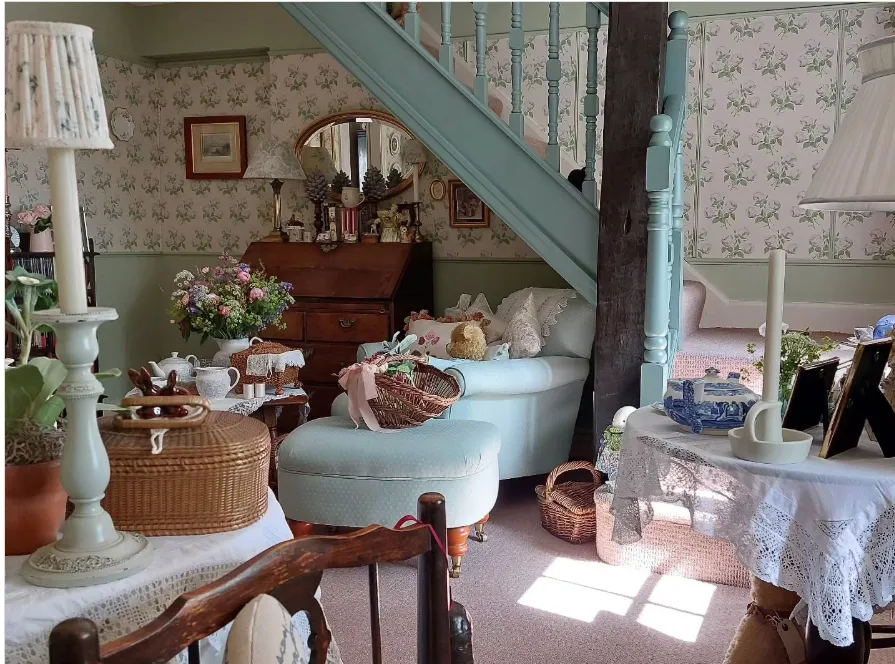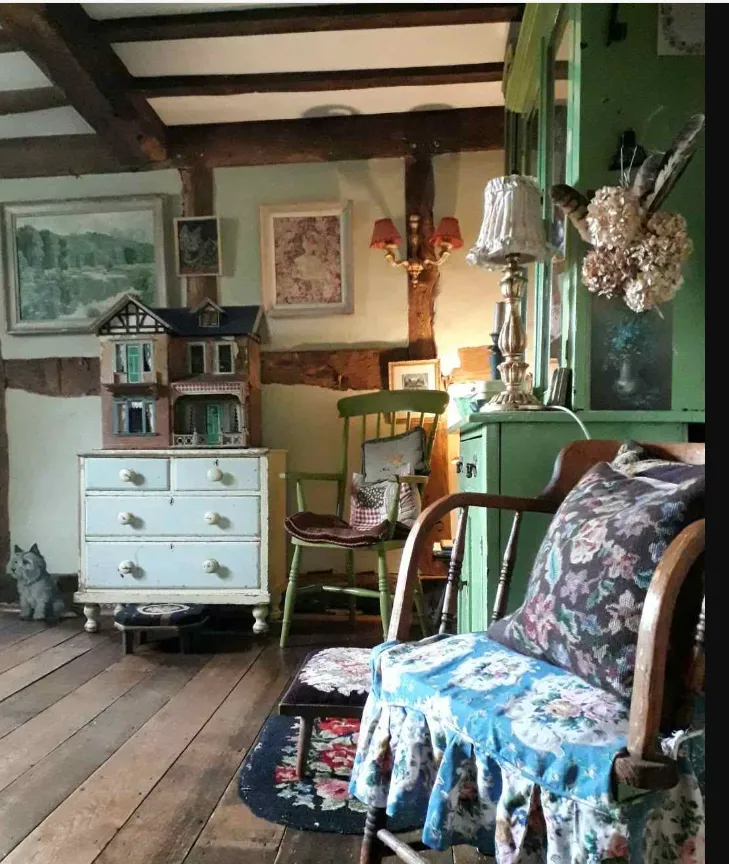When we first moved into our little cottage, I had big dreams of creating that classic English cottage living room — you know, the kind you see in Nancy Meyers movies or cozy country magazines. But reality? It looked more like a dentist’s waiting room. Beige walls. A too-stiff couch. Curtains that made me question every decision I’d made in life.

Advertisement
© 2025 AI Illustrator — Inspiration Only
image by pixabay
What I really wanted was a room where my kids could kick off their muddy boots, my husband could fall asleep mid-movie, and I could sip coffee on a Saturday morning with a blanket draped over my shoulders like I was in a BBC drama. It took a lot of trial, error, and secondhand shopping runs, but slowly, our living room became the kind of space that feels like a warm hug when you

© 2025 AI Illustrator — Inspiration Only
image by instagram
walk in.
If you’re dreaming of that same cozy, lived-in charm, here are the 14 things that truly made the difference — the things that turned my cold little box of a room into a space I never want to leave.

🏠 Home Decor Style Quiz
Find your perfect interior design style
1. What's your ideal weekend morning?
© 2025 AI Illustrator — Inspiration Only
Image source here.
Pack It In: Layer Plants Close Together
Cottage gardens thrive on abundance. Unlike the neatly spaced rows in modern landscaping, this style encourages you to tuck plants close together so they spill over paths, mix their scents, and invite bees and butterflies.
Plant tall flowers like hollyhocks behind bushier ones like lavender or catmint, and then add low-growing herbs at the edge. It feels wild in the best way.
Mix Flowers, Herbs, and Vegetables
One thing I’ve always loved about English cottage gardens is how practical they are. You’ll often find edible plants tucked between the blooms — lavender next to kale, roses near thyme,
tomatoes climbing beside nasturt iums.
It’s not just pretty — it’s purposeful.
Which Living Room Color Palette Fits You Best?
Discover the palette that reflects your style — take our free quick quiz and get instant decor inspiration!
Take the Quiz NowUse Curved, Meandering Pathways
There’s something magical about a path that doesn’t show you everything at once. Use flagstone, brick, or even pea gravel to create soft, curved walkways that lead the eye (and your feet) through the garden.
A winding path invites wandering. And that’s what a cottage garden is all about.
An English cottage garden blends structured elegance with soft, natural charm.
It balances winding paths, leafy hedges, and a joyful mix of colorful flowers to create a welcoming outdoor escape.
These gardens offer more than beauty—they invite you to slow down, sip your tea, and take in the simple pleasure of blooms and birdsong.
In the guide below, you’ll discover inspiring garden setups that reflect the heart of the cottage style. From vine-covered pergolas to tidy topiary corners, each idea is full of warmth and intention.
You’ll also find cozy details—like vintage benches, bird baths, and flowering arches—that give your garden personality and purpose.
Whether you’re creating a spot for afternoon daydreams or a pathway for pollinators, these ideas offer a beautiful place to begin.
A Pathway to Simplicity
A winding stone path meanders through flower beds and leads to a quaint, thatched-roof cottage.
Natural textures, soft greenery, and blooms spilling over the edges bring a gentle sense of calm.
It’s a space made for quiet mornings and barefoot strolls.
Recommended Decor Items:
▫ Vintage Wooden Wheelbarrow Planter – Shop on Amazon
▫ Stone Garden Bench – See it here
▫ Handcrafted Terracotta Plant Pots – View on Amazon
Hydrangea Haven
This garden surrounds a peaceful courtyard with hydrangeas blooming in soft blue and pink.
Climbing ivy hugs the stonework while a fountain bubbles in the center. The effect is romantic yet rooted in nature.
Recommended Decor Items:
▫ Classic Stone Garden Fountain – Shop now
▫ Wooden Garden Bench with Cushions – View it here
▫ Wrought Iron Garden Lantern – See on Amazon
Reflective Water Oasis
A still pond anchors this quiet garden. Lily pads drift gently while a curved stone bridge adds a poetic touch.
Delicate roses and leafy vines complete the look, ideal for those who crave a meditative, nature-filled escape.
Recommended Decor Items:
▫ Stone Garden Bridge – Check it out on Amazon
▫ Floating Water Lily Decor – See it here
▫ Vintage Metal Garden Arch – Shop now
Sunflower and Lavender Bliss
Golden sunflowers stretch toward the sky while purple lavender fills the air with fragrance.
A wooden bench under a shady tree makes this spot both playful and restful.
Recommended Decor Items:
▫ Rustic Wooden Garden Bench – View on Amazon
▫ Decorative Bee Hotels – Check price here
▫ Lavender Scented Sachets – Shop now
Rose-Lined Garden Path
A stone pathway drifts through clusters of blooming roses, lavender, and garden herbs.
Benches tucked into corners invite you to sit and stay a while. A white picket gate completes the classic cottage look.
Recommended Decor Items:
▫ White Picket Garden Gate – See it on Amazon
▫ Wooden Garden Bench with Backrest – View here
▫ Iron Trellis for Climbing Roses – Shop now
Springtime Archway Retreat
Cherry blossoms hang above while purple and white tulips bloom below. An iron bench invites you to pause in the middle of spring’s soft burst.
Recommended Decor Items:
▫ Wrought Iron Garden Bench – Shop on Amazon
▫ Cherry Blossom Tree Sapling – Check it out
▫ Decorative Garden Arches – View here
Ivy-Covered Archway Path
A curved path made of pebbles leads beneath an ivy-draped arch. Lavender edges the walkway while a lantern casts a golden evening glow.
Recommended Decor Items:
▫ Vintage Hanging Garden Lantern – See it here
▫ Metal Garden Arch for Ivy – Shop now
▫ Pebbled Pathway Stones – Check price on Amazon
Walled Garden Sanctuary
A brick wall surrounds this private garden, overgrown with ivy and lined with flowering hedges.
It’s a spot for tea, reading, or quiet thought.
Recommended Decor Items:
▫ Brick Effect Wall Planters – View it here
▫ Iron Garden Gate – Shop now
▫ Topiary Shears for Shaped Hedges – See on Amazon
Roses Against the Stone
Roses wrap gently around a stone wall as a cobbled path leads to a garden gate. Wild blooms and herbs fill every corner.
Recommended Decor Items:
▫ Wooden Cottage Garden Gate – Shop now
▫ Stone Planters for Wildflowers – View here
▫ Climbing Rose Support Trellis – Check it out
A Wisteria-Covered Garden Entrance
A wooden arch spills with cascading wisteria. The mossy pathway leads to a tucked-away garden shed surrounded by spring flowers.
Recommended Decor Items:
▫ Wooden Garden Archway – View it on Amazon
▫ Wisteria Climbing Plant Seeds – Shop now
▫ Decorative Wooden Shed – Check price
Twinkling Pergola at Dusk
A wooden pergola glows with fairy lights and climbing white roses. It’s the perfect setting for slow evenings outdoors.
Recommended Decor Items:
▫ LED String Fairy Lights – See it here
▫ Wooden Garden Pergola – Shop now
▫ Climbing White Rose Plant – View on Amazon
A Timeless Formal Garden
This structured garden highlights order: boxwood hedges, crisp borders, and a classic sundial as the centerpiece.
Recommended Decor Items:
▫ Cast Iron Sundial – View it on Amazon
▫ Wooden Garden Bench – Check price
A Blooming Pergola Walkway
Foxgloves and daisies rise along the sides of a wooden pergola. A wrought iron chair invites a pause for reflection beneath the soft canopy of green.
Recommended Decor Items:
▫ Wrought Iron Garden Chair – See on Amazon
▫ Wooden Garden Pergola – Shop now
▫ Mixed Foxglove Flower Seeds – View it here
Cottage Garden Perfection
A thatched-roof cottage is framed by box hedges and blooming borders. At its heart, a cast iron bird bath becomes a peaceful garden centerpiece.
Recommended Decor Items:
▫ Cast Iron Bird Bath – Check price
▫ Wooden Garden Archway – See on Amazon
Rose Garden Pathway
A gently curving path of stone leads through roses in every hue. A small wooden table and chair make it easy to linger with a book or a cup of tea.
Recommended Decor Items:
▫ Folding Wooden Garden Table – Shop here
▫ Climbing Red and Pink Rose Plants – View it on Amazon
▫ Stone Garden Path Pavers – Check price

